Today, we’re not really chatting about embroidery on the cutwork project we’ve been discussing lately. Instead, we’re going to go on a little detour.
I often find myself meandering into diverging paths, away from embroidery, when I’m trying to figure out solutions for tools, work station set-up, and the like for larger projects.
Oh, who am I kidding? Not just for larger projects – for any projects! I like the tool side of embroidery, I admit it. And given the opportunity, I will explore toolish ideas like a dedicated hound dog, if my interest is piqued and I think there’s value to the tool or it offers a unique or efficient solution.
I’m not into tools that are beautiful but completely impractical. I like tools that do their job well, and if they can be beautiful to boot, well, that’s just icing on the cake! When it comes to tools, I love nothing better than those that are both practical and beautiful.
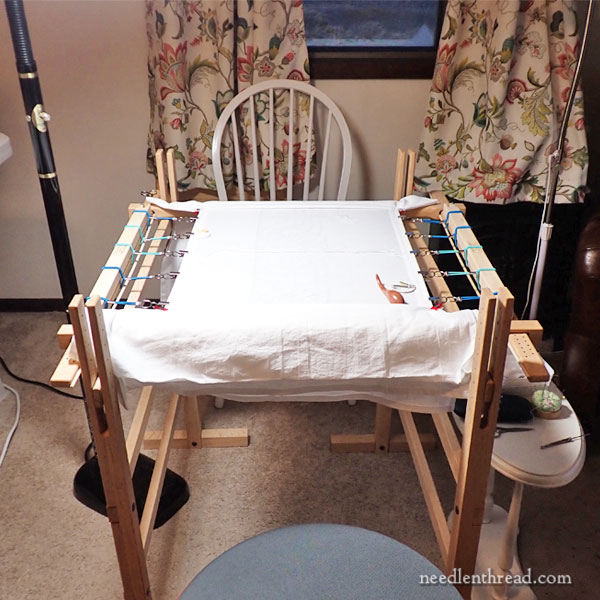
With the cutwork projects (on 17+ feet of linen), I had to think about how to reasonably set up the linen for stitching. I really think hoops would be a bad idea on this particular type of project (which has some dimension to it and is all white), so it seemed to me that the slate frame – or even a scroll frame, if it could handle the tension with this much fabric – would do the job.
And it does. Slate frames, which I’ve written about here, are made up of four simple pieces and some pegs. The horizontal bars, called rollers, can hold a fairly good amount of fabric rolled up and still keep the fabric under decent tension. The side arms, sometimes called slats, provide the vertical tension between the rollers by holding the rollers apart from each other with pegs.
I have only a few good slate frames and I’m finding that now, I need a few more. If you know anyone who is currently making strong, beautiful, well-made slate frames, I’m all ears! Or if you, or anyone you know, is de-stashing and has any frames they are interested in unloading, I could be your person. Contact me!
When it comes to slate frames, I like the ones that have more rounded rollers for the horizontal bars (they don’t have to be perfectly round, but if they are thicker and a bit rounded, I prefer that to a flat, thin roller), and that have smaller holes on the side stretcher arms – the types of holes that take a cotter pin as opposed to a thick wooden peg.
I know, I know. The wooden pegs are more authentic. But I’m not really concerned about historical accuracy with tools. I prefer tools that evolve over time into even better versions of themselves, because we have different ways of making things now. These days – well past, say, the 1400’s – I don’t mind using steel cotter pins on my frames!
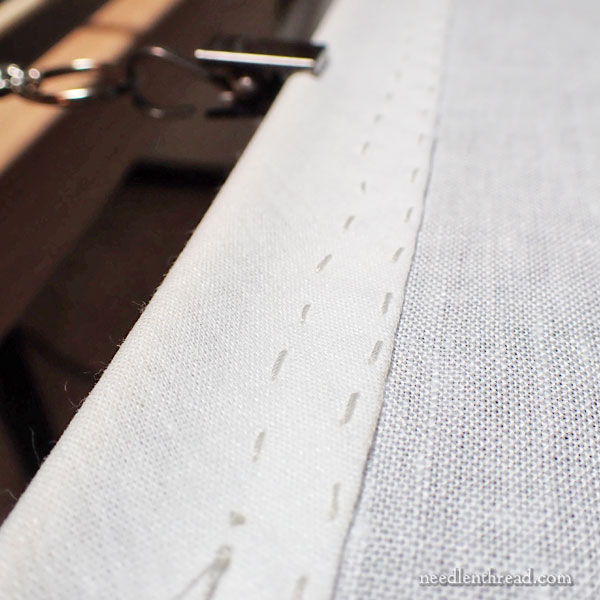
One step that I pretty much always take when setting up a slate frame now is sewing a small fold of other fabric (usually something similar to a very wide bias tape, folded in half) to the edge of my ground fabric. I use a herringbone stitch to sew the strip onto the fabric, and, if I’m lacing the frame, I lace through this piece of fabric rather than through the ground fabric. I reuse these folded strips until they’re pretty well spent.
The fabric can simply be a strip of other strong fabric, too, and it doesn’t necessarily have to be folded. But I like the fold, because I’ve found that inserting something into the fold seems to stabilize and make more consistent the tension supplied by lacing.
Sometimes, I’ll run a thick cord or string into the fold of the fabric for this purpose, or, lately, I’ve taken to inserting a small 3/16″ birch dowel into the fold and lacing around it. The dowel is easily slid in and out of the fold in the fabric.
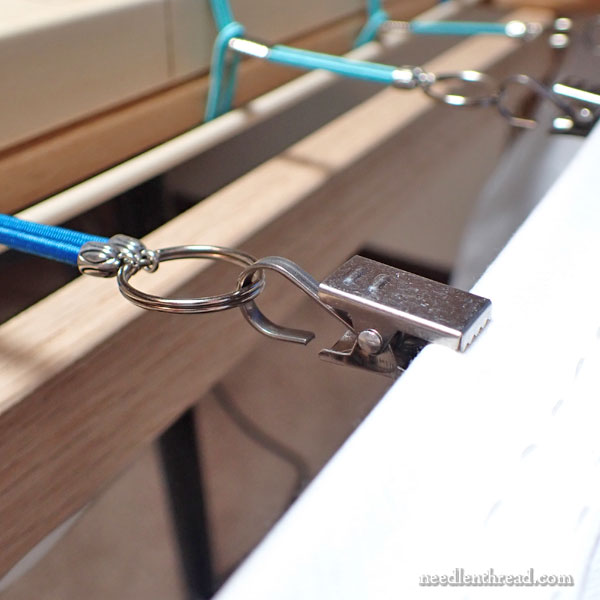
I’ve experimented several times with different types of tensioning besides lacing, but never with great success. My favorite heavy string for lacing the sides (a heavy linen thread, since linen doesn’t stretch like cotton does) tends to be somewhat expensive, and it’s a repeat cost that could be decreased if I had re-usable tensioners.
One type of tensioners available today for scroll frames are made from velcro, elastic straps, and suspender clips. I tried those, but didn’t like them.
Coming mostly out of Eastern Europe, I’ve seen tensioners like the ones above, involving a clip and a hook and stretchable cord, available in sets in various Etsy shops. I thought I would try some, and to that end, I ordered a set.
Of course, they haven’t come.
Will they ever? Who knows!
So I figured I could make my own and customize them to my notion of how they should work. Better yet, I figured I could make them mostly with goods I have easy access to, either on hand or that are made in the US, which meant not having to wait as long on supplies.
So I gathered supplies and started experimenting.
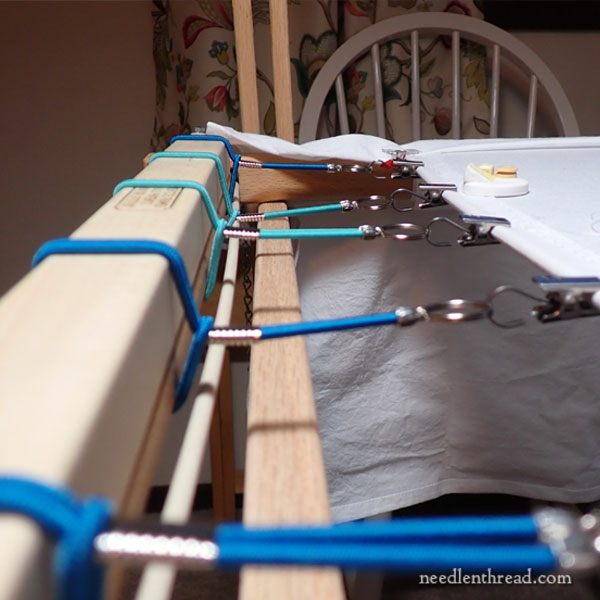
The first ones that I made, pictured above, are not the final concept. As they are, they don’t offer adjustability on their own. I had to insert some extra “frame” (using some individual stretcher bars on top of the side arms of my slate frames) to get the right tension on these. If my fabric were about an inch or so narrower, they would have worked fine.
To work well and universally for different sized projects, the tensioners need to be adjustable, and while some similar tensioners supply the adjustability through different areas where you can hook the clip, I don’t really like that way adjusting the tension. So I’ve come up with another configuration, and I’m going to make a new set based on this new idea.
I’ve been craving some down time where I can get a little obsessive about pursuing what I think will be a good solution. It looks like I just might have a couple hours today, and I can’t wait!
Incidentally, the dowel that you see in the photo above is another small problem I have to tackle, if I’m not tensioning a slate frame with lacing. When you lace a frame, you end up binding the corners of your frame, which adds to its stability. With tensioners, your corners are free, and this can mess with your frame’s stability. I inserted the dowels to take up the extra space in my frame intersections.
But I’ve got a solution in mind for that, too!
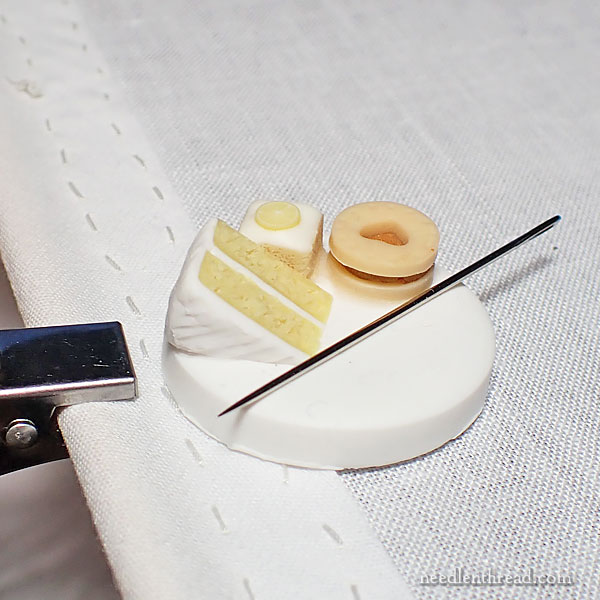
I love working at an established work station, and I especially love working on a slate frame set up on trestles. It’s comfortable, it’s efficient, and it’s roomy.
The way this work station is set up in the studio, Anna and I can both work on this piece, sitting across from each other. We’re only kickstarting the foundation on the linen, since the person who will eventually be embroidering it isn’t available yet. So the work station won’t be here for very long, but we get to enjoy it while it’s here!
We have plenty of room to work while sitting across from each other at the trestles. We have two good windows shedding light on the frame.
When we have time to stitch, we can just plop down and stitch! And if we have extended time, we can put on an audiobook or some good music and immerse ourselves.
And – better yet – we can use our own favorite needle minders in our own work space.
What could be better?
(That needle minder above was made by Cheryl at Chapel View Crafts in the UK. It was a gift from my niece. Every time I see it, I want tea. Isn’t it cute?)
We’ll probably revisit this whole tensioning subject soon! If you have any questions, thoughts, or suggestions, feel free to chime in below in the comment section!



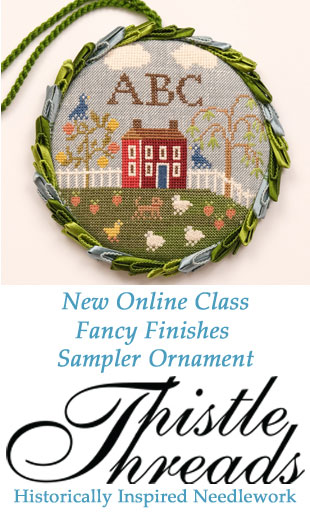



Hi Mary,
To make tension adjustable try “cord lock ends/stops”. Amazon offers a large variety. Last summer I saw the same set up at Etsy you describe, and experimented then too. I didn’t have nice crimps, and with the stoppers didn’t really need them. The setup worked very well for me. Tension was great.
Regina
Yes, I did. They do work better. Wrote about them today! But the upshot for me is that lacing does provide the best tension on large frames.
tea and cake!!!!
Indeed!!
If you do end up creating a better version of the tensioners with the clips so they can be adjustable, please share them with the world and sell them! I have Ukrainian ones right now and the only real drawback is they can’t be adjusted for different projects.
Have you thought about using Japanese Embroidery frames. They seem to be similar to the slate frame that you are using. I know they come in different lengths, etc.
Thanks, Pat! Yes, I have used a Japanese embroidery frame before, but I prefer a slate frame. They are a little more straightforward, and usually larger ones are more widely available, if you’re looking for a frame for a larger project.
Dear Mary,
This article is so fascinating! I’ve been intimidated to use a frame, but it seems that to get reliable, even tension, using a frame is essential.
I’ve found using hoops frustrating because the fabric doesn’t stay squarely on grain, and the tension is uneven. Then, when I need to rehoop the fabric, the tension will be at least a teensy bit different on the next section. Is this just my incompetence, or am I describing a typical situation when using a hoop? Perhaps you already have posted an article on successfully hooping fabric and I didn’t find it. Knowing that my ground fabric is wonky–which will ruin my project before I even start–puts me off investing my time in stitchery that will merely turn out cringe-inducing anyway.
Thanks for your informative and well-written posts!
Beth in Charlottesville
The San Francisco School of Needlework has slate frames for sale in their shop. 24”, $125 smackers.
I had the same reservation – lack of adjustability – about that type of side tensioner. What I’m using instead is the same hooks (small heavy duty curtain or photo hangers) and cord (shock cord or round elastic cord, 1/8” or 3mm in 10 yard packs) from Amazon. I space hooks about 2” apart along the sides of my ground cloth. I tie one end to the corner of my frame (or tie a loop to go over the knob of a scroll frame). Then I wrap the shock cord around the side of the frame, catching each wrap in a hook, and tie the shock cord to the other end of the frame. It’s much like lacing a slate frame, but much quicker, and is much more adjustable than the tensioners with the preset spacers. So far it’s giving me good consistent tension.
I love your work on side tension. That is something I have always been dissatisfied with on scroll frames. Please keep us posted. I want to buy some.
As for the needle minder. I could not have that on my work. I wouldn’t get any stitching done, because I would constantly be getting up looking for something sweet to eat. Not a good plan.
LOL! Yes, the needle minder is pretty enticing. I’ll most likely be writing more about the tensioners! I solved the adjustability issue and they are working pretty well!
Hi Mary, Are the extra 15 feet of linen wrapped tightly around the horizontal bars? In the photo it looks like they are draped on another bar and I can’t see where the 2nd person can sit with that in the way.
With a slate frame, can you just attach and stretch the sides and leave the top and bottom loose?
Thank you
All the excess is wrapped on the bar. What you’re seeing hanging there is the cloth we use to keep the frames covered.
I am working on my Certificate and Diploma from the RSN. When I began they sent a wonderful slate frame, which I placed on a good set of trestles. I found that it was impossible for me to use. If I sit up straight I can’t see the work and if I bend over to see, my back quickly begins to hurt horribly. I have tried many positions on the trestles but nothing works. So,I have had to use a System 4 and I lace with a unstretchable polyester/nylon cord normally used in jewelry making. It comes on spools from Michaels or Amazon. (INSPIRELLE 3mm Black Satin Cord Rattail Silk Cord Chinese Knot Thread for Jewelry ) I, also sew Eyelet Twill Tape Trim to the ground fabric. The grommets are perfect to lace through.
I still would love to use the slate frame. Do you have any ideas of how they might be used by people like me?
Thank you,
Frances
You can just use it with the NWS4 stand with the frame clamp, which is how I figure you must be using it. I do it all the time with the small ones.
I use a highly adjustable stool for sitting at the trestles. It’s called a buoy, by steelcase, and it rocks a bit – so you can lean forward and back on it, and swivel, and change the height easily. I like it a lot, but it’s probably an acquired taste. I use one at my work table, too. It’s not something I’d use often a rug under it – it slides a bit too much on a wood floor. But I like it as a work stool.
Did you ever try reclining trestles ? They should be a good option not to bend your work ?
There is a self published “book” by Nadine Sanders, aka the singing weaver, called ” Warping on a Shoestring”. She uses shoe strings to tension the warp on a loom. I converted all of my looms to this technique years ago. Adjusting tension where needed is easy. Some variation on this theme might work for you
As frustrating, interesting and experimental your journey with this project has been, I am enjoying learning.
Cheering you on!
Dear Mary, it seems that ‘somewhere in your youth or childhood’ you had an engineering degree! Such detailed, complicated construction work I’m in awe.
It is so interesting to get a glimpse of what goes on behind the scenes in your projects.
There’s so much more to ‘stitching’ than pushing a threaded needle through fabric!!
What a brilliant book your blogs would make. Or books!
Thanks for the inspiration. Clare
🙂 Thanks, Clare!
I’ve been improvising with stretchy cord and binder clips on a scroll frame. These help, but it is hard to make them perfectly equal in length and they are not adjustable. (But the cord is rather stretchy, so the lack of adjustability isn’t as much of an issue as it would otherwise be.)
Unfortunately, however well they worked, they won’t solve the problem of the frame warping out of true.
I solved the adjustability issue and made a new set that works great – and I blinged them up a bit, so they look good, too. LOL. I don’t have a problem making them equal lengths. (? a ruler helps!) I think the quality of the cord makes a huge difference. Once the frame is under good tension, it stays pretty true. And just to be sure, I made some adjustable corner cords, too. They all work great so far.
Thank you for describing your journey with this project. I just love to read about the details and how you think them through. I am hoping you can keep us in touch with the project after it leaves you!
Since you have such a long piece, I’m curious if using a floor quilt frame would give you the tension you need. Almost all quilts are rolled on the poles and then clamped along the sides on some type of “bungee” cord that adjusts to the width. I have my grandmothers hand quilt frame which has notches on the edges which allow the poles to be held in place and the quilt to be stretched if necessary. I normally roll from center out which allows me to start in the center and roll out to the edges. If longer than my frame, I do one half and then roll the finished side on like a take up pole and unroll to stitch out to the other side. My poles are 10 feet so I can stretch up to 120” width. 30” x 17 feet would easily roll onto the poles and scroll from one end to the other. To do the middle, just roll to the center and stitch the middle then roll out to the next notch in the side stands.
Hi, Debbie – Yes, any type of frame where the fabric can be strongly tensioned will work. The problem with a real quilting frame is, of course, the space. They generally have a pretty large footprint! In my “dream studio,” I’d have space for a big frame like that. About the largest frame I can accommodate here, though, is four feet, and that’s only if I take down my work table. :-/
Thanks Mary! I am wondering where you got your trestles? I ‘d like to get some from Canada or the US (or get my husband to make some!).
Sadly, the place I got them is no longer in business. Check ecclesiasticalsewing.com – they can special order from their woodworker.
The best slate frames, especially for large projects, I’ve found are made by Ecclesiastical Sewing. The frames are made here in the US so shipping costs aren’t prohibitive and the estimated delivery timeframes have been reliable. They are very well made. The group I work with has mounted many large scale projects that have included heavy material and even wire warp threads. Tension has remained even and taut.
Yes! I just bought one and it arrived today. It is fabulous!
For the problem of normal trestles being too flat so your neck and back are ruined by leaning over all the time, see this frame support that Margaret Lee sells: http://www.margaretlee.com.au/store/frames–accessories/supporting-frame-with-hand.html.
I had a woodworking friend make a copy for me, although it ended up costing more than shipping from Australia would have…but it works!
I hope this helps someone.